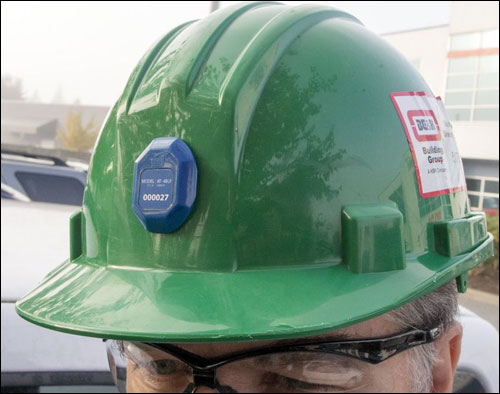An oil and gas company is installing a solution to locate personnel in the event of an emergency at its construction site in Newfoundland, Canada, using radio frequency identification technology provided by systems integrator Focus FS. The system consists of active RFID tags, readers, exciters and software from GuardRFID Solutions.
During most emergency events, oil and gas workers and construction crews are instructed to report to mustering locations, where they can be accounted for and evacuated in a short amount of time. However, when hundreds or thousands of individuals need to be located within a minimal span of time, performing headcounts manually via paper and pen, or by scanning bar codes printed on ID badges, is not a very efficient method. The Newfoundland oil and gas firm (which has requested to remain unnamed) asked Focus FS to provide a personnel-evacuation system that would allow the locations of individuals to be identified during an emergency in an automated manner, thereby offering management a real-time view into where everyone onsite is located.
Focus FS, based in St. John’s, Newfoundland, has been providing information-management solutions—such as personnel safety and evacuation, material-handling and material-flow systems—to the oil and gas company since 2012, and offered to investigate multiple options for emergency personnel management. Focus FS selected GuardRFID’s AllGuard Active RFID Platform, which was modified to fit the needs of the company’s site—measuring several square miles—where an oil platform is being built.
Focus FS knew that passive RFID would not provide the guaranteed, automatic tag reads required during an emergency, since passive technology’s read ranges are not as long as the company needed to ensure all tag IDs would be captured as people moved through portals. (A system using passive RFID tags would have a 95 to 98 percent read accuracy, according to Jeff Brown, Focus FS’ president, while one utilizing active tags could achieve closer to 100 percent.) At the same time, a real-time location system (RTLS) and battery-powered tags would require that readers be installed throughout the site. This, he says, would have been unrealistic since the site is often changing and moving. Instead, the GuardRFID system provides 433 MHz active AT-4 tags that remain dormant until awoken by 125 kHz low-frequency (LF) exciters at reader portals, at which time each tag transmits its own ID number, as well as that of the reader’s exciter. GuardRFID’s location-based Argus software then identifies the individual at specific chokepoints, such as entrances and exits to the site itself, as well as at locations where a person enters a new zone onsite, explains Zahir Abji, GuardRFID’s president and CEO.
GuardRFID provided the Canadian company with approximately 14 readers and about 25 exciters, which are installed temporarily at locations where they are needed for the job at hand. The system can then be easily moved to another location if work requirements change. “This allows flexibility in the location of receivers and exciters,” Brown states. “Chokepoints may change,” and the hardware can then move with those chokepoints.
All of the collected RFID read data is received by the Argus software, and is then managed by Focus FS’ software that links the information to the oil company’s own enterprise resource planning (ERP) software. The company will initially employ the technology to track the locations of individuals in the event of an emergency, while the system also enables management to view whether—and how quickly—zones are emptied out during an evacuation.
Each tag is attached to a hardhat worn by a specific worker. The tag’s unique ID number is then linked to that employee’s ID in the ERP software. Focus FS and GuardRFID opted against using RFID badges worn in pockets or on lanyards, since they could be misplaced or forgotten—or even create a safety risk if a lanyard were to become entangled in moving mechanical parts. A hardhat, on the other hand, is required for every worker before he or she can enter high-risk areas. When awoken by an exciter as a worker enters a specific area, the tag transmits its own ID to the reader, along with that of the exciter, and the software then determines that individual’s location based on the particular exciter that woke it up. The software can also calculate the direction in which an individual is travelling, based on the order of portals (indicating zones) through which he or she has passed.
The hardware is designed to be rugged, in order to accommodate such conditions as temperatures dropping as low as -40 degree Celsius (-40 degrees Fahrenheit) and heavy snowfall. However, the readers are typically installed in heated alcoves, thereby affording some protection.
The system is currently being installed, Brown reports, and will enable the locating of thousands of workers beginning in May or June.
By the end of the second quarter of this year, Focus FS and GuardRFID intend to release a commercialized version of the oil and gas personnel-tracking solution for use on or off shore, based on the system developed for the Canadian oil and gas company.


